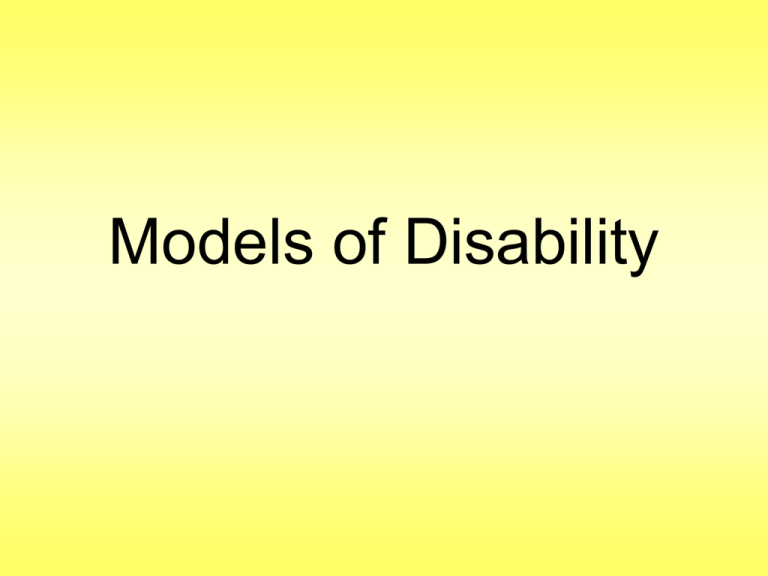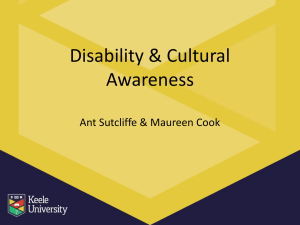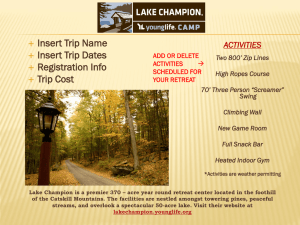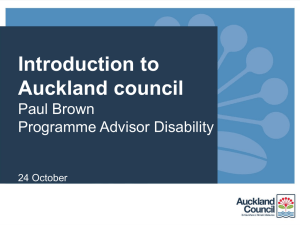Social - Leonard Cheshire Disability
advertisement

Models of Disability What ‘disabilities’ are there? A disability prevents some people from doing the things most other people can do Some examples of disability: • Visible – – – – – – Mobility difficulty Autism Cerebral palsy Stroke Asthma Multiple sclerosis • Invisible – – – – – – Cancer Hearing impairment Dyslexia Depression Epilepsy Pacemakers There are two main obstacles for a disabled person 1. The ideas and attitudes of people in society 2. The accessibility of the environment There are two models for thinking about disability and disabled people - ‘traditional medical’ and ‘social’ • The traditional medical model, historically originated by the medical profession, says that – Disability is a medical problem that needs to be overcome – The body is faulty and needs repair – Disabled people should be segregated from ‘normal’ society and put in special schools and day centres The Social Model Vic Finkelstein, an anti-apartheid activist,was one of the first people to coin the use of the model, comparing exclusion of disabled people to the exclusion of Black people in South Africa • The problem is the way that society views a person with a disability • Disabled people should be included in society • Society should see the person first and not the disablement • Diversity brings strength to all ‘Traditional Medical’ and ‘Social’ Models Case Study 1 • A school English teacher who works on the second floor breaks her back in a bicycle accident while on holiday in Australia. She wishes to continue teaching at the school as a wheelchair user. The school does not have a lift and is not due to get one for several years • What should be done? Case Study 1 Traditional Medical Social • Sorry but it’s not possible for you to work in this school anymore • We cannot relocate classrooms • There is no way of getting you up the stairs • It is not reasonable for you to expect to continue as a teacher when you are in a wheelchair • You are a valued teacher and we will do everything necessary to keep you on our staff • We can relocate classrooms so you can work on the ground floor. Staff meetings will be held downstairs. There is no need for you to go upstairs • We will ask the local authority to provide an access programme for the school to have a lift Case Study 1 The real story The teacher’s name is Lois Keith and she worked in Paddington. The school actually applied the social model and she continued as a teacher. She is also an author, editor and disability awareness trainer. Case Study 2 • A University lecturer plans a field trip to rural Kenya. The trip has been carried out every year for many years, visiting the same locations, staying in the same hotel and using the same travel arrangements. The trip is a vital part of the course. This year there is a wheelchair user in the class who wishes to go on the trip. • What should be done? Case Study 2 Traditional Medical Social • Sorry but its not practical • You are a valued student and we realise how important these trips to adapt the trip are for all students. We will do • There is limited electricity everything we can to include you supply so you will not be in as much of the trip as possible able to charge your • We have checked the field centre powered wheelchair and it is mostly accessible. The • We visit too many places travel arrangements are mostly in a day and you wouldn’t accessible but we will need an be able to keep up extra minibus and extra petrol for a • Some of the locations are generator in very rural areas and it • Two of the places we visit are will be impossible for you completely inaccessible so we will to get to them see if we can find alternatives Case Study 2 The real story • The university followed the social model. The student was allowed to go on the trip. During the previous year’s field trip the lecturer anticipated the need to accommodate a wheelchair user and took video and still pictures and discussed adaptations with the field centre staff • Most importantly, the lecturer consulted with the disabled student about the arrangements required. A little exercise… • Do you think you are independent? • Put up your hand if you think you ARE independent • Now put up your hand if you think are NOT independent • Some people think they are and some think they are not. • Let’s look more closely at this and see who is correct • Let's start with something to help us understand what ‘independence’ really means The question is…. • Who helped you to get ready this morning? • Did you do it all on your own? • Or did you depend on other people? • With the person sitting next to you, think about this and come up with some ideas • You have 3 minutes • Please start now Maker Loader Driver Fuel Delivery Van Carton Road Dairy Farmer Hundreds? Milk Cereal Sugar Person eating breakfast Chair Table Spoon Bowl Thousands? Millions? So you thought you were independent! • How wrong could you be? • Without the help of hundreds, thousands, even millions of people, none of us could accomplish anything Let’s ask the question again • Do you think you are independent? • Put up your hand if you think you ARE independent • Now put up your hand if you think are NOT independent What are the barriers? • Attitudinal barriers come from the way people think : if a barrier is thought of as a given it can stop people from thinking of a creative solution, even thinking ‘I don’t have the time to do that’ is a barrier • Physical barriers include the built environment: stairways, blocked lifts or access routes, narrow doorways So… which model will you use? • I hope this has given you an insight into the difference between the traditional medical and social models of disability • Adopting the social model, quite literally, makes the world of difference








![You can the presentation here [Powerpoint, 1.01MB]](http://s2.studylib.net/store/data/005417570_1-0810139cfc2485ebcaf952e0ae8bb49a-300x300.png)


